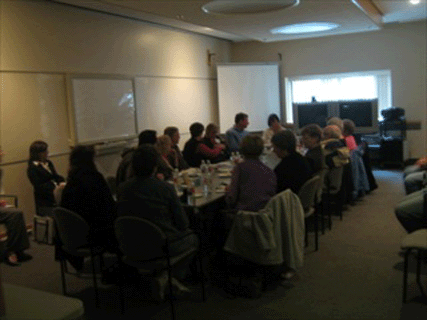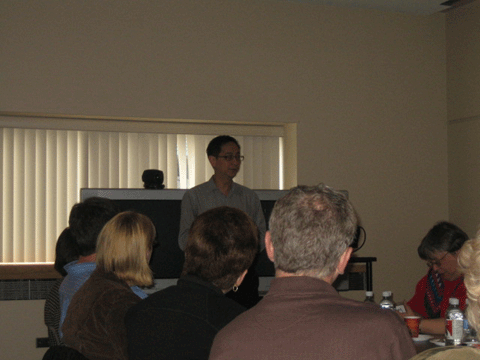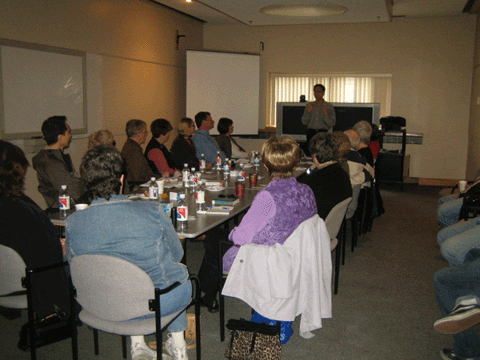BEBCRF Support Group Meeting – Vancouver, Spring 2008
Presenter:
Dr. Joseph K.C. Tsui
The meeting was called to order by Chairperson Heather Brown. With three new members, she started the meeting with a round-table discussion so that every member had a chance to get acquainted before the arrival of the guest speaker. Dr. Tsui arrived during the round-table discussion and was able to hear many of the members' concerns and questions. He had no problem waiting until everyone was done to collect as much information as he could before starting his talk.
 Round Table Discussion.
Round Table Discussion.
Dr. Joseph K.C. Tsui
Dr. Tsui (commonly pronounced as CHOY but, the official Mandarin spelling and pronunciation are XU), a Neurologist, arrived in Canada in 1985. His first project was to work with a product called 'Oculinum'. Today we know the product as BOTOX®. Dr. Tsui is affiliated with the University of British Columbia's Pacific Parkinson's Research Centre, and, has authored and co-authored over 36 medical papers dealing with various aspects of Dystonia.
Benign Essential Blepharospasm is a subset of dystonia. There are many conditions that are categorically under this classification. Dr. Tsui believes that dystonia may also be divided into 'adult-onset' and 'childhood-onset'. Childhood-onset starts with the legs and progresses upward to the full body. It seldom involves the eyes. It will go as far as the neck and, sometimes, the jaw.
On the other hand, the adult-onset of dystonia can happen in any part of the body: the hand, the foot, the neck or face, etc. but it rarely spreads to multiple points of the body. If it spreads, it will be locally; for example from the face to the neck region. Adult-onset is also known as 'focal' dystonia because it is focused to one specific part of the body.
The most common form of focal dystonia involves the neck: followed by the eyelids (blepharospasm). It may start with the lower portion of the face and jaw. This along with blepharospasm is also referred to as 'cranial' dystonia, and, if the neck is also involved it is called 'cranial cervical' dystonia. Dystonia involving the head or 'cranium' is called 'focal' because the cranial region is the only or 'local' area in which it spreads.
When it affects the eyes only it is called blepharospasm, and, when it affects the lower face and jaw it is called Meige Syndrome.
 Dr. Joseph K. C. Tsu.
Dr. Joseph K. C. Tsu.
For some reason when blepharospasm spreads to the lower face and neck, the pattern is very different from the 'focal neck' dystonia. It is most common for 'focal neck' dystonia to be found principally on one side of the neck. For Meige and blepharospasm the disease spreads down to the jaws, and the front of the neck. Frequently this means that the patient has difficulty opening or closing the jaw. Often the patient complains of pain in and around the neck. A common pattern is that the eyes would shut, the jaws would open, and the chin pulled towards the neck. This image was portrayed in a classical painting by Brueghel several centuries ago.
One of Dr. Tsui's patients was being injected around the eyes for blepharospasm. The patient complained of a pain in the neck and on a subsequent visit Dr. Tsui decided to inject the neck in lieu of the eyes and found that both the neck pain and the blepharospasm were favourably affected. The doctor concludes that in the 'local' spreading of the disease there may be a common triggering area that seems to affect all facets of the clinical manifestation.
The natural progression of this disease is quite insidious in that it progresses slowly. It may appear quite suddenly in some cases buts its progression is rather slow. Often it takes two (2) years for the disease to peak and, thereafter, is quite stable in its intensity. However, in these two first years the symptoms can fluctuate quite widely. Oftimes they may disappear only to reappear some time later. From five (5) years on the disease is quite stable and seldom spreads for about seventeen (17) years. There are cases where a patient can go into remission after fifteen (15) years. However, cautions Dr. Tsui, there are no hard and fast rules that can be followed.
The cause of this disease is not yet known and, if there is a genetic role, it is not readily evident. While the genetic inheritance of generalized dystonia is more definite, it is believed that focal dystonia may also be related to a gene, but that gene has never been found. Nor has the question of heredity been proven conclusively. The question of genetics is an on-going study.
Dr. Tsui prefers to think of blepharospasm as a 'software' problem. The 'hardware', eyes and related areas in the brain, have been examined and scanned to the point where it is conclusive that nothing is physically wrong. However, it is known that the 'basal ganglia', which is a very complicated structure located in the brain above the 'brainstem' and between the 'cerebral cortex' and 'thalamus', is the central point through which the 'software' (natural brain commands) pass and/or reside in order to get to various parts of the body. Within the 'basal ganglia' reside many 'programmes' including the one that is 'at rest'; that is, even though a person is not moving it is that 'programme' resident in the 'basal ganglia' that keeps one standing or sitting up straight and that controls the normal blink function of the eyes.
 Vancouver Members and Guest.
Vancouver Members and Guest.
This 'resident programme' is working all the time. Something goes wrong and there is a stream of 'blink' commands that go out to the eyes. The person becomes aware of this erroneous behaviour and the situation becomes quite stressful. The more one is aware of this condition the greater the stress generated and the more the messages go out to the eyes. The more one fights to 'control' the blinking the more messages are sent out by the brain. Simply put, one may say that this is the whole idea of dystonia: the constant barrage of uncontrollable messages.
A technique used for some cases of general dystonia is 'Deep Brain Stimulation' (DBS). For example, persons treated for 'tremor' will generally improve for a short period of time using this technique. In patients with other forms of dystonia, improvement may be delayed for a lengthy period of time. DBS does not limit necessarily, the possibility of subsequent drug or botulinum toxin treatments. 'Deep Brain Stimulation' is in its relatively early stages as a treatment for this disorder. The preliminary results are quite positive and the procedure is expected to evolve over time as more patients are treated and more data are collected
One of the most effective treatments for blepharospasm is botulinum toxin injections. This technique has been used effectively for more than twenty (20) years with virtually no significant systemic side effects. Although it is a toxin the quantities required are so minute that there is no danger to the patient. No evidence has yet surfaced to indicate that the muscles injected are permanently damaged. In fact there is every indication that this process is completely reversible.
One fact has emerged over the past twenty plus years: once the maximum dosage has been reached that effectively controls or paralyzes the muscle, the addition of more toxin does not prolong the period of coverage or muscle inactivity. Patients begin with a low dosage and the doctor, combined with patient feedback, increases the dosage until maximum 'saturation', if you will, for the muscle being injected is reached. Increasing the dosage beyond this point may cause the excess toxin to 'bleed' from the muscle being injected into an adjacent muscle which then often causes side effects related to weakness in untargeted muscles for the patient.
Essentially the injected muscle, with the optimum dosage, is partially paralyzed and cannot process the signal sent to it. For each patient, there is a specific time in which the muscle will eventually grow new pathways for the messages being sent from the brain. It is the completion of this re-connection that causes the eye-closures to return. Once again, it should be noted that over-saturation of the muscles with botulinum toxin does not increase the length of time between the re-connection but rather increases the chances of 'spilling' over and effecting adjacent muscles.
BOTOX® is a registered trademark of Allergan Corporation

